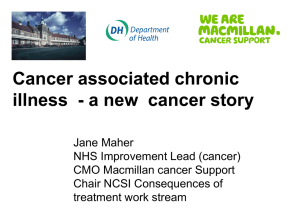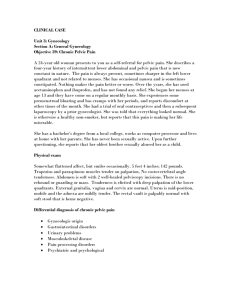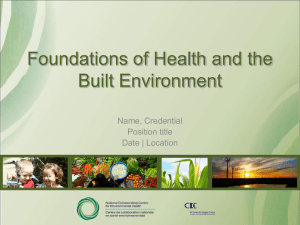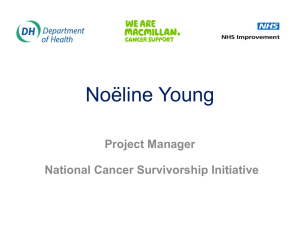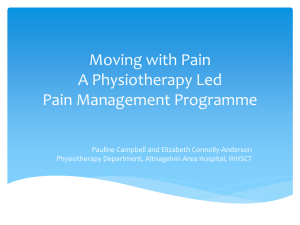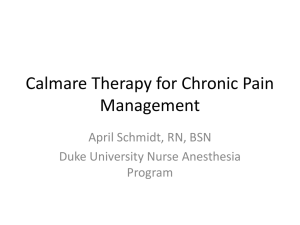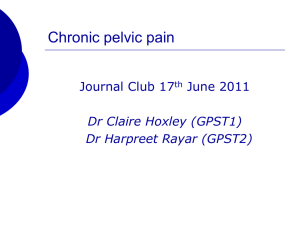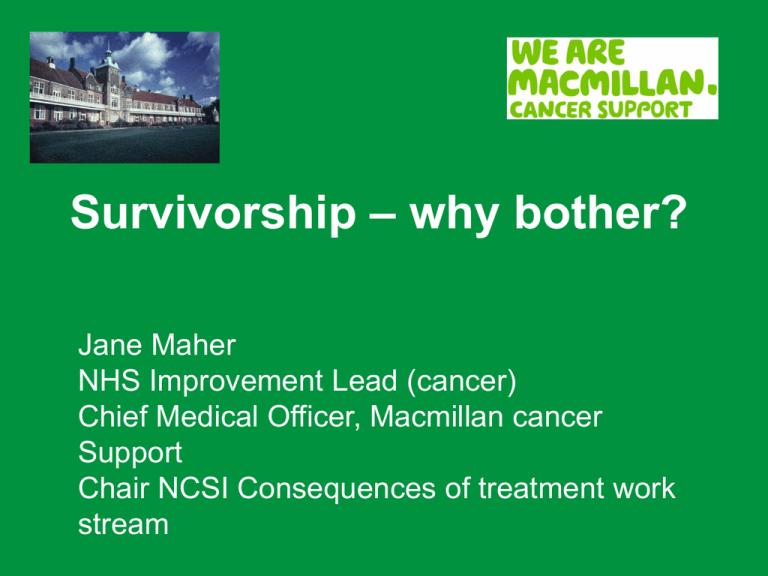
Survivorship – why bother?
Jane Maher
NHS Improvement Lead (cancer)
Chief Medical Officer, Macmillan cancer
Support
Chair NCSI Consequences of treatment work
stream
Public view of cancer 2007
Incurable cancer
Cured cancer
Cancer in the UK in 2008
There were 300,000 new cases of cancer in the UK in
2008.
There were 150,000 cancer deaths in the UK in 2008.
There were two million cancer survivors in the UK in 2008.
Ten per cent of those over the age of 65 are cancer
survivors – this figure is increasing by 3.2% each year.
Redesigning cancer care
Diagnosis &
treatment
Recovery
Monitoring
Managing transitions
Chronic and
Progressive
End of life care
Quantifying the invisible
5
End of life care
Progressive illness
Later monitoring
Early monitoring: 5
Early monitoring: 2 ≥ 5
Rehabilitation
End of life care
Progressive illness
Later monitoring
Early monitoring: 5 ≥
10 years
Early monitoring: 2 ≥ 5
years
Rehabilitation
End of life care
Progressive illness
Later monitoring
Early monitoring: 5 ≥ 10
Early monitoring: 2 ≥ 5
Rehabilitation
Diagnosis & Treatment
Number of people
Diagnosis &
Treatment
Diagnosis &
Treatment
Using available data and clinically led
assumptions we estimate phases in the
survivorship population
Example Pathways
Recovery
7
The months after treatment
Armes et al Journal clinical oncology 2009
Move More
Daily Mail
08 August 2011
CIRC: 2,047,206
More lifestyle illnesses
More other chronic conditions
osteoporosis & prostate cancer
OR:
1.59
Nada Khan
In press BJC
*Adjusted for smoking and underweight
Matched to non-cancer survivor controls on the basis of age, sex and practice
More chronic conditions
Heart failure & breast cancer
OR: 1.33
Nada
Khan
In press
BJC
*Adjusted for BMI, smoking
Matched to non-cancer survivor controls on the basis of age, sex and practice
Monitoring
14
Literature review concerning
current follow up after cancer
“A
poor evidence base and no consensus as to
the intensity, duration, setting or type of follow up
required for most common forms of cancer”
Evidence to inform the Cancer Reform Strategy : The clinical
effectiveness and cost effectiveness of follow up services after
cancer treatment ; York Centre for reviews and dissemination
October 2007
(report available on request)
Change from a “one size fits all”
approach
Pre-planned tests, triage,
access back to specialists via
trusted person
Trusted individuals able to provide
Information
Access to tests
Access to expertise
Tools
Ongoing support
NCSI testing communities ….
Many of the changes required to
improve care and support are
already in use, others are being
piloted.
38 pilot sites around the country,
testing approaches to care and
support
Almost 80 centres involved
In addition, 19 Health and
Wellbeing clinics by Macmillan
Treatment consequences
20
New chronic conditions
RT & CT related illnesses
e.g pelvic cancers
?
17,000/ year pelvic RT (UK)
gynaecological, urological,
colorectal, anal cancers
80,000 living after pelvic RT
Bowel, urinary, sexual issues
Patients referred to a
gastroenterologist a median of 2
years after pelvic RT (n =265)
Rectal bleeding 171
Urgency
82
Frequency
80
Faecal leakage 79
Cancer 12%
Unrelated 38%
Most > 1 diagnosis
Most could be helped
Andreyev 2005
‘My GP says for a long
time he did not know
what was going on…I
thought I was making a
fuss.’
‘‘My oncologist
asked how I was –
how embarrassing
to tell him.’
‘It’s the little
things put
together that
wear us down’
•Endocrine
•Growth /bone health
•Cognitive/hear/sight
•Cardiac dysfunction
•Renal dysfunction
•Infertility & sexuality
•Bowels/bladder
•Second tumours
Gill Levitt 2008
Treatable incurable cancer
25
Cancer which has spread…
Cancer which has spread
Cancer which is incurable
Recurrent cancer & the need for early
treatment with chemotherapy ?
0.75
0.50
0.25
0.00
Proportion surviving
1.00
Early
Delayed
0
6
12
18
24
30
36
42
Months since randomisation
48
54
60
Ovarian cancer (OVO 5) Same Survival early cancer treatment or wait
for symptoms
(Rustin et al 2009)
Palliative care can improve survival
as much as chemotherapy
End of Life
31
.
When does survivorship end?
Health professionals poor at
predicting prognosis in the last
year of life
Errors (more than double or
less than half of actual
survival) 30% of the time
Two thirds of these errors are
overoptimistic
Glare P et al, A Systematic Review
of Physicians Survival Predictions
in Terminally Ill Cancer Patients,
British Medical Journal 2003, 327,
195-8
Using IT
GP
research
database
Radiation
episode
statistics
Cancer
registry
Patient
reported
outcomes
Hospital
episode
statistics
Chemo
prescriptions
REACH - Website
3.4 million
Information ….
39
Survivorship Coverage
Building
one team
•The same story
•Smooth hand offs
•A sense of continuity
•Personalised
Nurses & AHPs
http://www.cancerconsequences.org/index.html
12 Post Doc nurses & AHPS taking the agenda forward.
• To improve care for people living with the effects of cancer
• Bridge the gap between research and practice
• Individual and collective projects
• Influencing UK research and policy agenda
Working through influential
communities
‘Some are born great, some
become great, some have
greatness thrust upon them.’
Malvolio, Twelfth Night,
Shakespeare
A new cancer story ….
Some cancers are born chronic .
Some cancers become chronic
Some survivors have chronic illness thrust upon
them – through treatment.
And some are not chronic at all.
Thank you

